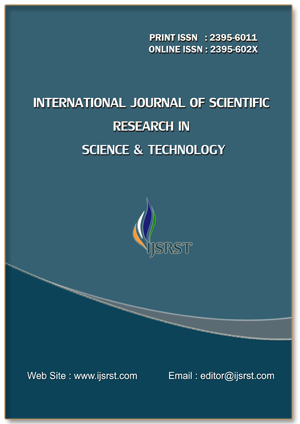Review on Synthesis of Thiazole Derivatives from α-Halo- ketones and Thiourea or N-Substituted Thiourea
DOI:
https://doi.org/10.32628/IJSRST207466Keywords:
Review, thiazole, thiourea, N-substituted thiourea, 2-aminothiazole, Hantzsch processAbstract
Thiazole represents important class of heterocyclic compounds. Thiazole and its derivatives have been reported to possess antitubercular, antibacterial, anti-inflammatory, anticancer, antifungal activity. Several methods of synthesis of thiazole derivatives have been reported, but most widely used synthetic approach to obtained thiazole derivatives is Hantzsch process. It involved synthesis of thiazole derivative from ?-halo-carbonyl compounds and thiourea or thiourea derivatives. This review mainly focuses on the research work reported in the scientific literature on the different procedures of synthesis of 2-amino thiazole and their derivatives.
References
- D. Caceres, et al. Tet Lett. , 2012, 53, 3934-3936.
- Yan Ping Zhu, J J Yuan., et al., Tetrahedron, 2012, 68,173, 178.
- Y. K. Abhale, P. C. Mhaske, IJSRST,2017, 3( 9).
- S.K. Bharati, G. Nath, R. Tilak, et al., Eur. J. Med. Chem. 2010, 45, 651-660
- M. D. Kinnick, P. Lind, et al., J. Med. Chem. 1995, 38, 4929
- K. Tsuji, H. Ishikawa, Bioorg. Med. Chem. Lett. 1994, 4, 1601
- Osman SAA, Abdalla AA, Alaib MO. J Pharm Sci. 1983;72:68.
- Tandon V K, Yadav D B, et al., Bioorg Med Chem. 2006;14:6120.
- Cai P, Kong F, et al., J Nat Prod. 2005;68:1736.
- Holla B S, Malini K V, et al., Europ. Journal of Med. Chem. 2003, 38, 313-318.
- Kalkhambkar R G, Kulkarni G M, et al., European Journal of Med. Chem. 2007, 42,1272-1276.
- Haviv, J. D. Ratajczyk, R. W. DeNet, et al., Journal of Med. Chem., vol. 31, no. 9, pp. 1719–1728, 1988.
- F.W. Bell, A. S. Cantrell, M. H¨ogberg, et al., Journal of Med. Chem., vol. 38, no. 25, pp. 4929–4936, 1995.
- K. Tsuji and H. Ishikawa, Bioorg. Med. Chem. Lett., 1994 , 4, 1601
- B.V. Yang, D.S. Weinstein, et al., J. Med. Chem. 2010, 53, 8241–8251.
- Ramírez J, Svetaz L, et al., Eur J Med Chem, 2015, 92, 866.
- Ramla MM, Omar MA, et al., Bioorganic and Med. Chem., 2006, 14, 7324-7332.
- Gulsory E, Guzeldemirci NU.. European Journal of Med. Chem., 2007, 42, 320-326.
- McInnes, C., Drug Discov. Today, 2008, 13(19-20), 875-881.
- E.L. Luzina, A.V. Popov, Eur. J. Med. Chem., 2009,44, 4944
- Cushing, T. D.; Metz, D. P., et al., J. Med. Chem. 2012, 55, 8559−8581.
- Romagnoli, R.; Baraldi, P. G.; Salvador, et al., Med. Chem. 2012, 55, 5433−5445.
- E. O. Olawode, R. Tandlich et al., Bioorganic and Medicinal Chemistry letters, 2019,29, 1572-1575.
- M. A. Potopnyk, R. Lytvyn et al., Journal of Organic Chem. 2018, 83, 1095-1105.
- Deepak Mishra, Atiya Fatima, et al. Der Chemica Sinica, 2015,6(8), 14-18.
- S. S. Kottawar, T. M. Potewar, et al., Heterocyclic Letters, 2015, 5(2) , 279-283.
- S. Zheng, Q. Zhong et al, ACS Medicinal Chemistry letters, 2013,4(20), 191-196.
- G. Ramesh, B. Janardhan, et al., Research on Chemical Intermediates, 2015, 41 (11), 8099-8109.
- T. V. Sravanthi, S. L. Manju, Journal of Fluorescence, 2015, 25 (6), 1727-1738.
- S. N. Dighe, P. K. Chaskar, et al. ,ISRN Organic Chemistry, 2011, 434613, 6 pp.
- Hans-Peter Buchstaller , Uwe Anlauf, Combinatorial Chemistry and High Throughput Screening, 2011,14, 104-108.
- J. Banothu, K Vaarlaa, et al.,Chinese Chem. Letters, 2014, 25, 172-175.
- S. Rostamizadeh, R. Aryan et al., Monatsh Chem, 2008,139, 1241-1245.
- T. M. Potewar, S. A. Ingale, et al., Tetrahedron 2008, 64 5019–5022.
- T. M. Potewar, S.A. Ingale, et al., Tetrahedron, 2007, 63, 11066-11069.
- D. Caceres-Castilo, R. M. Carballo, et al., Tetrahedron Letters, 2012, 53, 3934-3936.
Downloads
Published
Issue
Section
License
Copyright (c) IJSRST

This work is licensed under a Creative Commons Attribution 4.0 International License.

